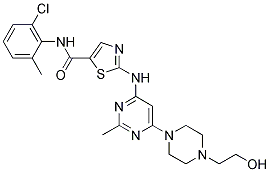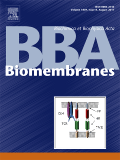All AbMole products are for research use only, cannot be used for human consumption.

Dasatinib (BMS-354825) is a small molecule inhibitor of both the SRC and BCR/ABL tyrosine kinases, with IC50's for the isolated kinases of 0.55 and 3.0 nM, respectively. Dasatinib also inhibits Lyn (IC50 = 8.5 nM) and Src (IC50 = 3.0 nM) kinase activities in vitro using 0.1 mg/mL poly (Glu4-Tyr) as the substrate. Dasatinib has greater potency than imatinib mesylate and has activity against the majority of kinase mutations in imatinib-resistant chronic myeloid leukemia.

Res Pract Thromb Haemost. 2024 Oct 05.
Functional characterization of a nanobody based GPVI specific platelet agonist
Dasatinib purchased from AbMole

Nat Commun. 2023 Nov 27;14(1):7783.
Local H2 release remodels senescence microenvironment for improved repair of injured bone
Dasatinib purchased from AbMole

Patent. CN114451401A 2022 May 10.
Patent. CN114451401A
Dasatinib purchased from AbMole

Patent. EP3987006A1 2022 Apr 27.
Patent. EP3987006A1
Dasatinib purchased from AbMole

J Virol. 2020 Feb 14;94(5):e01791-19.
Targeting Kaposi's Sarcoma-Associated Herpesvirus ORF21 Tyrosine Kinase and Viral Lytic Reactivation by Tyrosine Kinase Inhibitors Approved for Clinical Use
Dasatinib purchased from AbMole

Patent. WO2020256637A1 2020 Dec 24.
Patent. WO2020256637A1
Dasatinib purchased from AbMole

Biochim Biophys Acta. 2017 Jan;1864(1):12-22.
Involvement of caveolin-1 in low shear stress-induced breast cancer cell motility and adhesion: Roles of FAK/Src and ROCK/p-MLC pathways.
Dasatinib purchased from AbMole
| Cell Experiment | |
|---|---|
| Cell lines | Ba/F3 cell lines |
| Preparation method | Cellular proliferation assays. Ba/F3 cell lines were plated in triplicate and incubated with escalating concentrations of imatinib, AMN107, or BMS-354825 for 72 hours. Proliferation was measured using a methanethiosulfonate-based viability assay (CellTiter96 Aqueous One Solution Reagent; Promega). IC50 and IC90 values are reported as the mean of three independent experiments done in quadruplicate. The inhibitor concentration ranges for IC50 and IC90 determinations were 0 to 2,000 nmol/L (imatinib and AMN107) or 0 to 32 nmol/L (BMS-354825). The imatinib concentration range was extended to 6,400 nmol/L for mutants with IC50 >2,000 nmol/L. The BMS-354825 concentration range was extended to 200 nmol/L for mutant T315I. |
| Concentrations | 0~2000nM |
| Incubation time | 72 h |
| Animal Experiment | |
|---|---|
| Animal models | primary human Ph+ B-ALL xenografts |
| Formulation | dissolved in a mixture of polypropylene glycol (Sigma-Aldrich) diluted in water (50:50) |
| Dosages | 5 mg/kg/day for two weeks |
| Administration | oral gavage |
| Molecular Weight | 488.01 |
| Formula | C22H26ClN7O2S |
| CAS Number | 302962-49-8 |
| Solubility (25°C) | DMSO 68 mg/mL |
| Storage |
Powder -20°C 3 years ; 4°C 2 years In solvent -80°C 6 months ; -20°C 1 month |
| Related Src-bcr-Abl Products |
|---|
| KX2-361
KX2-361 (KX-02) is a Src-kinase and tubulin polymerization inhibitor. KX2-361 shows anti-tumor activity and induces apoptosis of Glioblastoma (GBM) cell. KX2-361 shows good oral bioavailability and readily crosses the BBB in mice. |
| Risvodetinib
Risvodetinib (IkT-148009) is an orally active, selective and brain-penetrant protein tyrosine kinase inhibitor, displaying excellent target efficacy against c-Abl1, c-Abl2/Arg with IC50 values of 33 nM, 14 nM, respectively. |
| SI-2 hydrochloride
SI-2 hydrochloride is a highly promising SRC-3 inhibitor (PPI) with acceptable oral availability, with IC50 values of 3-20 nM for breast cancer cell death. |
| KB SRC 4
KB SRC 4 is a potent, and highly selective c-Src inhibitor, with a Ki of 44 nM and a Kd of 86 nM, and shows no inhibition on c-Abl up to 125 μM; KB SRC 4 has antitumor activity. |
| Hydroxymethyl dasatinib
Hydroxymethyl dasatinib (M24), a benzylhydroxy metabolite of Dasatinib, exhibits an IC50 of 46.7nM in K562 CML cells. |
All AbMole products are for research use only, cannot be used for human consumption or veterinary use. We do not provide products or services to individuals. Please comply with the intended use and do not use AbMole products for any other purpose.


Products are for research use only. Not for human use. We do not sell to patients.
© Copyright 2010-2024 AbMole BioScience. All Rights Reserved.
